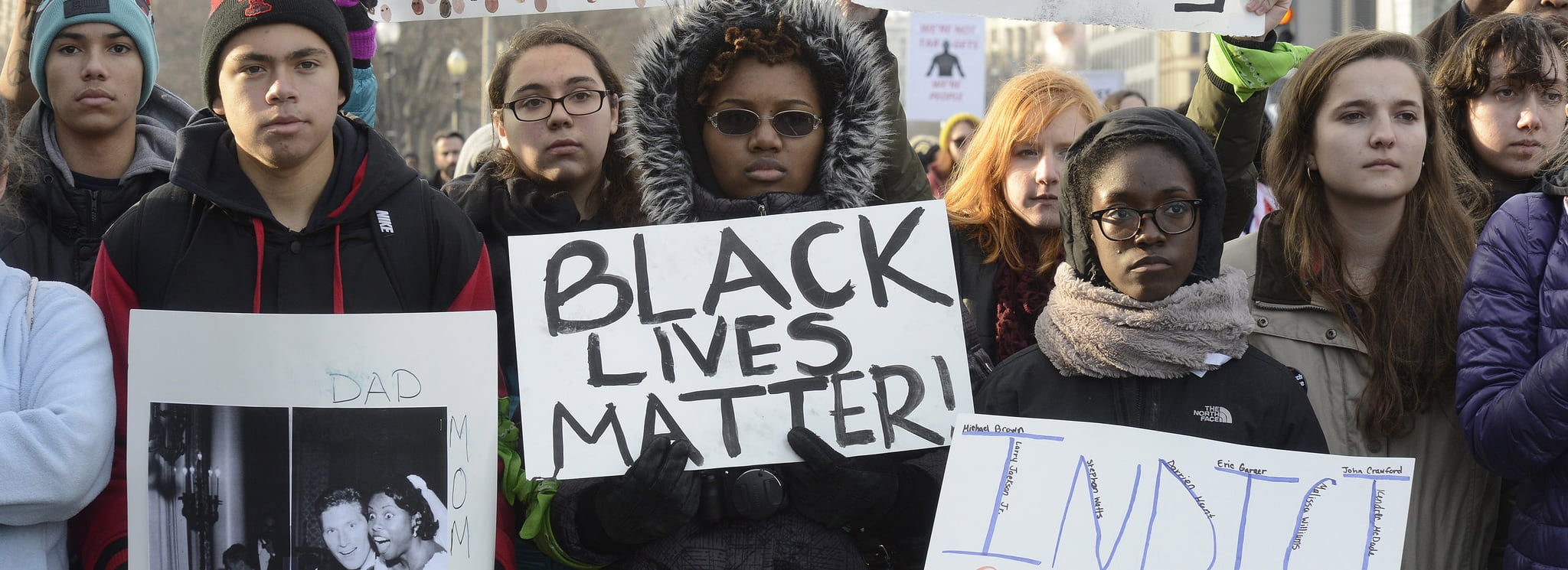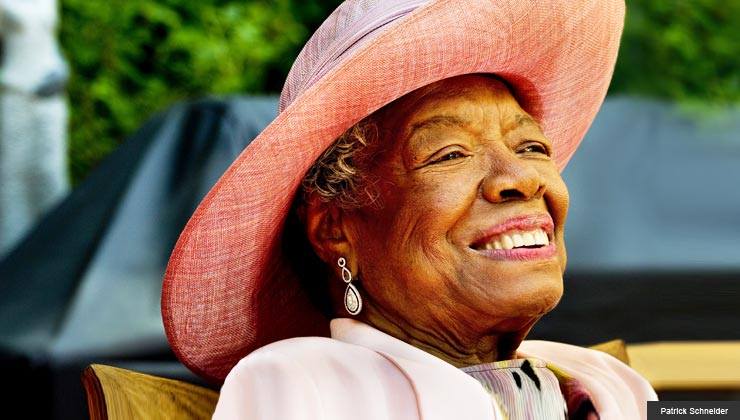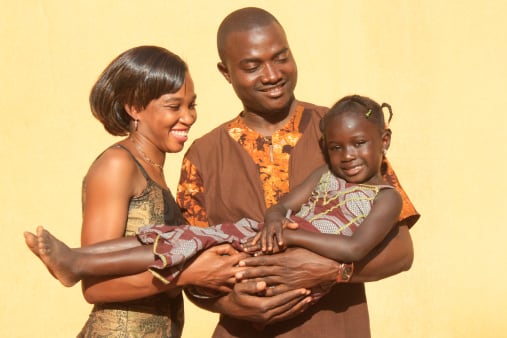
Saa Naasel, 3, Jayelin Robinson , 6, and Liliana Wheeler, 5, with signs saying “Our Lives Matter” at the Justice for All March. (Photo courtesy of Kenrya Rankin Naasel)
Violence against black men and boys is increasingly a national public health issue. As black parents endure the immeasurable pain of burying their children, a new generation of activists is passing our tradition of protest — in the name of justice — to their children.
Kenrya Rankin Naasel’s daughter is only 3 years old, but she was determined to have Saa participate in the Justice for All march on Saturday in Washington, D.C.
“Skipping it was not an option,” said Naasel, 33, of Columbia, Md. “I wanted her to know, even at her young age, that we are our most powerful when we are united.”
Her friend, Leilani Wheeler, took her 5-year-old daughter, Liliana, to the march for similar reasons. “It is important to teach our children to stand up for themselves and others,” said Wheeler, also 33, of Silver Spring, Md.
The Naasels and Wheelers united with hundreds of thousands of people of every stripe in cities from coast to coast on Saturday to protest racial profiling and police brutality while demonstrating that “Black Lives Matter” — a slogan that has become the signature of the movement on the streets and the Internet.
“I wanted her to see what it looks like when thousands of people come together to advocate for themselves,” Naasel said of her daughter. “I wanted her to feel the energy that is generated when people have had enough and decide to do something about it. So we took to the streets.”
RT @thisstopstoday #EricGarner‘s kid dies-in on the spot her father was killed @es_snipes #11days #ThisStopsToday pic.twitter.com/fHp5XMDgZW
— Legal Defense Fund (@NAACP_LDF) December 12, 2014
For weeks now, streets have been overflowing with people rallying, marching and holding “die-ins” after grand juries decided against indictment for the officers who killed Michael Brown in Ferguson, Mo., and Eric Garner in Staten Island, N.Y. Major arteries have been blocked such as the West Side Highway, FDR Drive and Brooklyn Bridge in New York.
It reminds U.S. Rep. John Lewis, D-Ga., of “Bloody Sunday” when he marched across the Edmund Pettus Bridge in Selma, Ala., in 1965 and led subsequent marches there with the Rev. Dr. Martin Luther King Jr.
Lewis, who has been arrested and beaten dozens of times as a leader of the Student Non-Violent Coordinating Committee, is particularly proud to witness so many young people taking a stand.
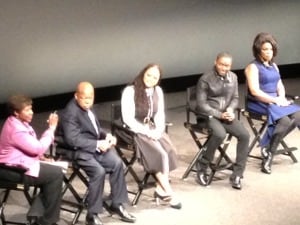
Gwen Ifill discusses protests with U.S. Rep. John Lewis, “Selma” director Ava DuVernay and actors Daniel Oyelowo and Lorraine Toussaint at D.C. premiere. (Photo: Yanick Rice Lamb/Fierce)
“It’s beautiful; I’m so glad I lived to see it,” the 74-year-old activist said during a discussion Thursday night at the Washington premiere of the film “Selma” at the Newseum.
Lewis and many others at the screening praised director Ava DuVernay and the cast of “Selma,” which portrays everyday people strategizing to fight injustices in similar ways to today’s protestors.
“We felt that this is going to be a reminder of civil disobedience tactics,” said DuVernay, whose film was nominated for four Golden Globe Awards earlier in the day and opens nationally Jan. 9. “It’s not a one-person-led movement; it’s a people-led movement.”
“There’s something brewing,” DuVernay added. “There’s collaborative energy for change.”
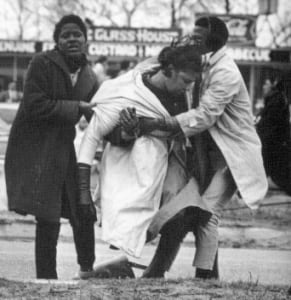
Amelia Boynton was tear-gassed and nearly beaten to death on “Bloody Sunday” in Selma, Ala. (Photo: Public Domain)
Lorraine Toussaint welcomes a change, saying it’s important for citizens to rid themselves of “malaise and apathy.” Toussaint portrays Selma activist Amelia Boynton, now 103, who was nearly beaten to death on Bloody Sunday.
A key parallel between the current protests and those in Selma was the shooting death of Jimmie Lee Jackson by an Alabama state trooper weeks earlier in February 1965. The Selma protests were inspired in part by Jackson’s death and led to the Voting Rights Act of 1965.
The trooper, James Fowler, claimed that he shot Jackson in self-defense. He was finally indicted four decades later in 2007, after telling his story in a local newspaper. He served six months behind bars from 2010 to 2011 as part of a plea bargain, according to the Civil Rights Cold Case Project.
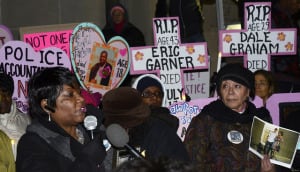
Grieving mothers gather at a vigil co-sponsored by Mothers Against Police Brutality outside the Dept. of Justice. (Photo: Stephen D. Melkisethian/Creative Commons)
Self-defense was also claimed in the deaths of Eric Garner in New York, Michael Brown in Missouri, Trayvon Martin in Florida and Tamir Rice in Ohio. Their survivors and other family members who have lost loved ones violently often by the bullets or chokeholds of police officers have shared their stories at protests across the country. Grieving mothers also gathered at a vigil co-sponsored by Mothers Against Police Brutality outside the Dept. of Justice on Wednesday.
In addition to public gatherings, protesters have taken to social media with many people blacking out or obliterating their images on their Facebook pages over the weekend. Many people participated in Blackout Friday, bypassing the holiday-shopping kickoff entirely or spending their dollars only with black-owned businesses.
Although the financial impact of the boycott is unclear, total shopping during Thanksgiving weekend, which includes multiple trips by the same person, dropped roughly 6 percent from 248.6 million to 233.3 million, according to the National Retail Federation.
I told my kids that I love them, but I’m not buying Christmas gifts this year in solidarity w/ #NotOneDime. I will make them something. — Nekima Levy-Pounds (@nvlevy) December 6, 2014
Erica Young, 33, of Clinton, Md., wants her 6-year-old nephew, Jayelin Robinson, to grow up in a different world that’s safer for black boys and men.
“I believe that this is a historic movement, and he needed to be there,” Young said. “I wanted to connect the issues we read about and see on the news with what is going on close to home.”
“It was important to show him that he can make his voice heard.”
Yanick Rice Lamb, who teaches journalism at Howard University, is co-founder of FierceforBlackWomen.com.
The NAACP, an organizer of the Justice for All march with the Rev. Al Sharpton and the National Action Network, released a report in September with grassroots strategies to deal racial profiling. The report, called “Born Suspect: Stop-and-Frisk Abuses and the Continued Fight to End Racial Profiling in America,” also looks at statistics and law enforcement practices in various states.

